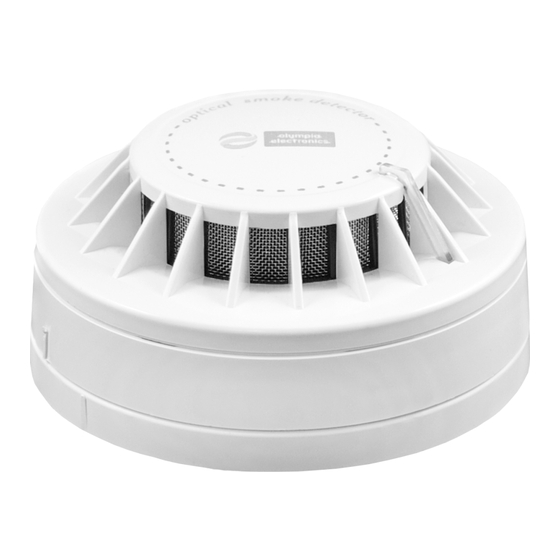
Advertisement
BSR-6055/A
ADDRESSABLE OPTICAL SMOKE DETECTOR
TECHNICAL CHARACTERISTICS
OPERATION VOLTAGE
IDLE STATE POWER CONSUMPTION
ALARM POWER CONSUMPTION
SENSITIVITY
INDICATORS
OUTPUT
DEGREES OF COVER PROTECTION
PRODUCED IN ACCORDANCE WITH
OPERATION TEMPERATURE RANGE
RELATIVE HUMIDITY
EXTERNAL DIMENSIONS
TYPICAL WEIGHT
GUARANTEE
Thank you for your trust in our products.
Olympia Electronics - European manufacturer.
GENERAL
Before installing the detector, the user must
read these instructions carefully and store this
manual for future reference.
BSR-6055/A is an addressable optical smoke
detector. It co-operates with BSR-1116 and
BSR-2100 panels. The device transmits an
analogue value to the panel which depends
on the amount of the smoke that there is in the
area. The analogue value is 100 with
obscuration rate 0.120dB/m (small amount of
smoke).
The factory setting of the panel is to issue an
alarm when the analogue value is greater
than 110.
The user can change from the panel this
analogue value from 100 (high sensitivity) up
to 120 (low sensitivity).
They have two parts, one plastic base which is
installed on the ceiling and the main unit of the
detector which is fastened to the base by a
simple turning to the right.
The detectors have an indication led which
lights continuously in case of fire detection
until there is a reset signal from the panel.
When we silence the sirens the LED remains lit
to show us the detector that issued the alarm.
The LED goes off when we RESET the panel.
The indication led also flashes every 8 sec to
indicate good operation.
ADDRESS SETTING
To set each detector's address you have to use
the device BSR-2143 photo. 1. (refer to it's
instruction manual). After the address setting
Page 1 from 2
21-28V DC
1mA
1.5 mA (with indication LED activated)
0.120dB/m
Alarm LED
to external LED driver (BS-572)
IP20
EN 54-7
o
-10 to 60 C
Up to 95%
103 (diam.) x 48 (height) mm
160gr.
2 years
mark this number to the sticker on the
detector's base (ADR:XXX). Each detector
must have an address with which it is
recognized from the panel.
It`s forbidden for two devices with same
addresses to be connect to the same loop.
OPERATION CHECK
The operation check can be done by spraying a
small amount of smoke into the detector's
chamber. You can use the special smoke
device A-752 of our company, or a similar
device.
It is advised to conduct a good operation test
every 6 months and every time the detector
position is changed.
It is essential to have good air circulation inside
the detector. Therefore care must be taken so
that the vents of the detector are not covered.
NOTE
The detectors must be placed in the ceiling on
visible areas with no side obstacles and away
from sides with no air circulation or strong air
currents and vapors. Each detector covers
2
almost 50 m
and the distance between two
detectors must not exceed 15m. Also the
detectors must be placed away from
fluorescent tubes at least 50 cm.
The cables cross section must be from 0.5 to
2
1.5mm .
ATTENTION!!
After the device is
installed, care must be
taken, so that the detector vents are not blocked
by anything (i.e. dust, paint). Failing to do so
will prevent the smoke particles to enter the
detection chamber.
921605502_09_015
Advertisement
Table of Contents

Summary of Contents for olympia electronics BSR-6055/A
- Page 1 BSR-6055/A is an addressable optical smoke It`s forbidden for two devices with same detector. It co-operates with BSR-1116 and addresses to be connect to the same loop.
- Page 2 60061 Olympia Electronics reserves the right to repair or to replace the returned goods and to or not charge production under CPR number: GREECE the buyer depending on the reason of defection. Olympia Electronics reserves the right to charge or not the buyer the transportation cost.





Need help?
Do you have a question about the BSR-6055/A and is the answer not in the manual?
Questions and answers